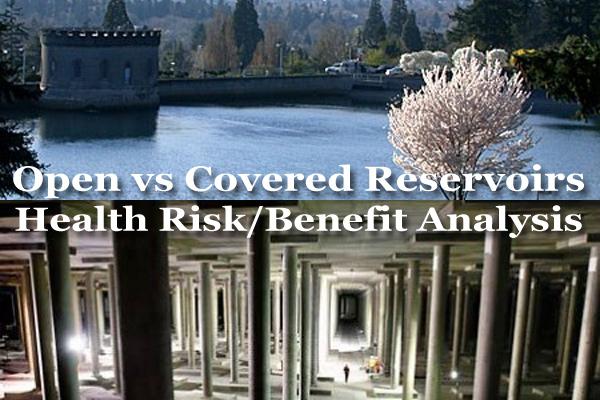Posted Aug 11, 2013

In an attempt to be as unbiased as possible, I have done hours of research with the ultimate goal of finding definitive health risk/benefit studies, white papers, and other documents on the issue of open vs covered reservoirs. With all the huge controversy one would expect there to be at least one definitive answer provided by the EPA, but so far I haven't found it. I was amazed first of all when I started searching that Portland is the veritable center of the Universe on this issue:
www.google.com/search?q=open+covered+reservoirs+risk+benefit
ARGUMENTS IN FAVOR OF COVERED RESERVOIRS
The following report was presented to me by one of the "skeptics" in the comments of a Portland Water Bureau page who referenced it in support of their claim that "the long scientific consensus has been that Uncovered reservoirs are less safe & healthy":
EPA - Uncovered Finished Water Reservoirs Guidance Manual
www.epa.gov/ogwdw/mdbp/pdf/uncover/ufw8p.pdf
But when you actually look at it you can see very quickly even just from the opening description that it is merely a maintenance and risk mitigation instruction manual for uncovered reservoirs: "The purpose of this document is to provide a basic understanding of the potential sources of external contamination in uncovered finished water reservoirs and to provide guidance to water treatment operators for evaluating and maintaining water quality in these reservoirs."
But that is not a valid reason on its own to necessitate covered reservoirs because there are health risks to ANY water storage method.
Furthermore, while this is ostensibly a neutral source since it is published by the EPA, and at first glance it might seem that Joe Glicker's name appears in the Acknowledgements section merely because he is an expert in the field, a funny thing happens when you look for the Word doc version instead of the pdf. Google says: "by J Glicker"
www.google.com/search?q=water.epa.gov%2Flawsregs%2Frulesregs%2Fsdwa%2Fmdbp%2Fupload%2Fufw8p.doc
Seattle Public Utilities Drinking Water Quality Report 2008
www.seattle.gov/util/groups/public/@spu/@water/documents/webcontent/spu01_005056.pdf
I'm referencing 2008 because their most recent report does not go into the same level of detail on claims of risk from open reservoirs and benefits of closed reservoirs. The look and feel of this one also is that of the usual Public Relations spin to justify what was surely a controversial expenditure.
First of all keep in mind that this report says that "very low levels of Cryptosporidium have been detected in our raw water". This does not apply in Portland, as confirmed by the Oregon Health Authority whose main argument for denial of exemption from LT2 was E. coli (a vastly overstated risk which did not result in any known health incident other than a boil water warning which I assume was just to avoid litigation in the highly unlikely case that anyone actually did get sick).
Trihalomethanes: "You have to treat surface water with chlorine to prevent microbial growth. But a by-product of the chlorination process is trihalomethanes and haloacetic acids, which are linked to certain cancers. In Seattle’s water, because it starts off cleaner and we cover our reservoirs, we can use less chlorine and as a result, we have rates of these compounds well within safe ranges."
What they don't mention is how open air reservoirs allow those gases to dissipate, as opposed to covered reservoirs whose vents (according to Scott Fernandez) are not large enough for 100% of the gases to escape. This is verifiable by simply comparing to Portland's report which shows half as much trihalomethanes:
www.portlandoregon.gov/water/article/244813
Of course even Seattle's maximum of 60 ppm is below the EPA's MCL of 80 ppm, but the point is that Seattle's covered reservoirs have higher risk in that category.
Reservoir Covering (here's where you can virtually hear the spinmeister wheels turning): "Our reservoir-covering program -- which will create 76-acres of new public open space -- is one example of a multiple-benefit project. Reservoir covering improves water quality and saves costs by reducing chlorine requirements and increases security. And when they are covered with grass, reservoirs become open space we all can enjoy. Talk about a win-win!"
Public space is nice but so are the aesthetics of open reservoirs.
Increased security is a benefit (but see more on this below).
Chlorine. Now finally here's a solid argument. Chlorine levels are important, even more so since recent studies have demonstrated some food allergies can be caused by chlorine. Seattle has half as much chlorine residual compared to Portland and their report claims that less chlorine is required in covered reservoirs. So this is one factor to consider in the overall risk/benefit analysis but keep in mind that Portland's average 2.2 ppm is still well below the MCL of 4 ppm.
Saving Water: "SPU has done its job reducing distribution system leakage through our reservoir-covering program that reduces evaporation."
Okay, that sounds reasonable, though there is no indication exactly how much is saved nor whether it's worth the cost and potential health risks.
ARGUMENTS IN FAVOR OF OPEN RESERVOIRS
Please at least skim over the first two references because they explain so much and they are relatively easy to understand:
Friends of the Reservoirs - Water Quality Issues
www.friendsofreservoirs.org/resources/IRP/Water%20Quality%20Issues.pdf
Benefits of Deep Open Water Reservoirs by Scott Fernandez
www.friendsofreservoirs.org/resources/IRP/Benefits%20of%20Deep%20Open%20Water%20Reservoirs.pdf
History of LT2 Rule as it pertains to City of Portland
www.oregonwild.org/waters/bull_run/City_of_Portland_and_the_LT2_Rule.pdf
January 9, 2004: Official comments submitted by “Unfiltered Systems Working Group” (Boston, NY, San Francisco, Seattle, Tacoma) state that draft rule overestimates risks and benefits, while underestimating major capital costs. NYC requests language that would allow for exemptions or variances to rule.
2004: An EPA LT2 Federal Advisory Committee consultant leads a Portland Reservoir Review panel that comprehensively examines the open reservoir issue, looking at all issues including water quality, security, age of facilities, costs, and historical significance. The reservoir panel remains unconvinced that there is any need or that there would be any public health benefit to eliminating the open reservoirs. The committee supports risk mitigation.
January 5, 2006: The risk mitigation option was inexplicably eliminated in the final rule despite the lack of any data collection on open reservoirs and any science to support burying or covering open reservoirs. The EPA documented public health problems in covered and buried storage only, none in open reservoirs.
EPA - Finished Water Storage Facilities
www.epa.gov/safewater/disinfection/tcr/pdfs/whitepaper_tcr_storage.pdf
"The goal of this document is to review existing literature, research and information on the potential public health implications associated with covered storage reservoirs."
The security risks of open reservoirs are greatly exaggerated plus there are ways that they could be mitigated such as video cameras and patrols. Also, covered reservoirs do not eliminate security risks. For example:
Vandals tossed sealed bottle of hydrochloric acid into Portland reservoir [underground]
www.oregonlive.com/portland/index.ssf/2012/08/vandals_toss_sealed_bottle_of.html
Discovering an incident with a major covered reservoir may take a long time because they are cleaned so infrequently and because people can't easily see the water. In contrast, water in open reservoirs is visible and they are cleaned frequently.
If people are worried about terrorists or crazy people putting stuff in our water, this article from 2011 discusses how public water is an unlikely target:
http://cnsnews.com/news/article/us-cities-cover-open-drinking-water-reservoirs
And furthermore, moving the water underground doesn't eliminate terrorist threats, which can potentially include an inside job perpetrated by a utility employee or national "security" establishment false flag event. I personally feel safer when citizens also participate in the monitoring process.
And finally, the risks from wildlife have also been greatly exaggerated.
Don’t Drink the Water! If you did, you’d know what a crazy, panicked overreaction we had to the latest contamination scare.
www.wweek.com/portland/article-19505-don%E2%80%99t_drink_the_water_.html
"Number of bears it would take defecating in the reservoir to cause a disease outbreak, according to Oxman: Many, many bears defecating continually, or 'one bear that had just the right organism, defecating repeatedly'."
Now with that wonderful image keep in mind that the Oregon Health Authority's main reason for denying the City's request for deferral was NOT Cryptosporidium, but the overhyped non-infectious E. coli non-incident that was later traced to a solitary seagull.
So it's worth repeating: “An overestimate of risk reduces the consumer’s confidence in public water supply and may be misused by less scrupulous interest groups.”
MICROBIOLOGIST vs CONSTRUCTION ENGINEER
The scientific debate centers on two people, Scott Fernandez vs Joe Glicker. When you have two scientists debating each other and the layman is not qualified and/or too busy to delve deep enough into the science, it generally comes down to the question of which one you trust.
1) Which person's arguments sound more reasonable?
2) Which one has demonstrated more competence?
3) Which one has a profit motivated conflict of interest?
Portland Water Bureau's public relations manager Tim Hall claims that CH2M Hill is "one of the best engineering firms for reservoir design", but the next two references reveal major flaws in their Seattle reservoirs, the exact same design as the one they're building on Powell Butte:
Major do-over for two Seattle reservoirs
http://seattletimes.com/html/localnews/2009485902_reservoir17m.html
Questions over whether 4 buried reservoirs can withstand quake
http://seattletimes.com/html/localnews/2019692615_reservoirs16m.html
Some have argued that Seattle Public Utilities bears the responsibility for decisions they made as opposed to contractor negligence. At the very least, these reports prove how complications can arise when building new reservoirs.
As for Joe Glicker, for starters going back two decades ago it is documented that he was found guilty of defamation and harassment when he was PWB's Director of Water Operations:
www.pamplinmedia.com/component/content/article?id=120518
And check out this Oregonian article:
www.oregonlive.com/environment/index.ssf/2011/03/concerns_rise_on_portlands_cos.html
"The most alarming example in EPA's 1999 manual on open reservoirs -- a pigeon-spurred salmonella outbreak that killed seven people and sickened 60 percent of the population of Gideon, Mo., in 1993 -- actually started in a covered tank with unscreened vents, giving the birds a secluded spot to roost."
I've heard that Portland's covered reservoirs will have screened vents, but keep in mind that's the same manual as mentioned above that appears to have been primarily authored by Joe Glicker, which greatly calls into question his credibility.
A Friend in the Business
Reservoir advocates accuse Portland's Water Bureau of playing favorites.
www.wweek.com/portland/article-2423-a_friend_in_the_business.html
Allegations of MWH and CH2M Hill corruption are not limited to Portland and Seattle:
Central Coast of California
www.slocoastjournal.com/docs/archives/2010/Nov/pages/news2.html
"Portland residents' allegations of inappropriate government influence by MWH, have some similarities to allegations made and concerns expressed by residents of Morro Bay and Los Osos. In both communities, it has been suggested that former MWH employees in positions of influence have steered local projects toward contracts with MWH, when better alternatives were available."
Tampa Bay, Florida
www.thebradentontimes.com/news/2013/07/06/opinion/usace_adopts_flawed_study_..._again
"During the 10-year period of construction and repair, the price of water from Tampa Bay Water (TBW) has almost doubled, even though a successful water conservation program reduced the overall use of water throughout the region."
The same trend of higher rates with lowered consumption has happened here. Now take a guess which global corporation is behind that as well as the Water Wars here in Portland. That's right, CH2M HILL!
There is also the following website which I have not verified and it could use more references, but it's worth taking a look:
Who Is Joe Glicker?
http://whoisjoeglicker.wordpress.com
Click Here for Comments on Facebook
Home Page
